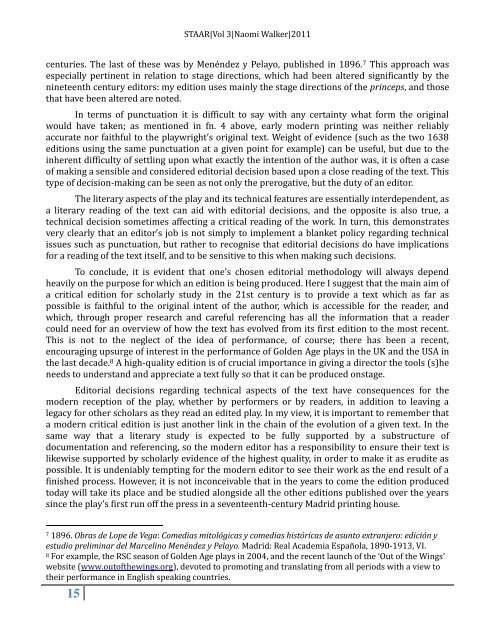STAAR Volume 3 - St. Anne's MCR
STAAR Volume 3 - St. Anne's MCR
STAAR Volume 3 - St. Anne's MCR
You also want an ePaper? Increase the reach of your titles
YUMPU automatically turns print PDFs into web optimized ePapers that Google loves.
15<br />
<strong>STAAR</strong>|Vol 3|Naomi Walker|2011<br />
centuries. The last of these was by Menéndez y Pelayo, published in 1896. 7 This approach was<br />
especially pertinent in relation to stage directions, which had been altered significantly by the<br />
nineteenth century editors: my edition uses mainly the stage directions of the princeps, and those<br />
that have been altered are noted.<br />
In terms of punctuation it is difficult to say with any certainty what form the original<br />
would have taken; as mentioned in fn. 4 above, early modern printing was neither reliably<br />
accurate nor faithful to the playwright’s original text. Weight of evidence (such as the two 1638<br />
editions using the same punctuation at a given point for example) can be useful, but due to the<br />
inherent difficulty of settling upon what exactly the intention of the author was, it is often a case<br />
of making a sensible and considered editorial decision based upon a close reading of the text. This<br />
type of decision-making can be seen as not only the prerogative, but the duty of an editor.<br />
The literary aspects of the play and its technical features are essentially interdependent, as<br />
a literary reading of the text can aid with editorial decisions, and the opposite is also true, a<br />
technical decision sometimes affecting a critical reading of the work. In turn, this demonstrates<br />
very clearly that an editor’s job is not simply to implement a blanket policy regarding technical<br />
issues such as punctuation, but rather to recognise that editorial decisions do have implications<br />
for a reading of the text itself, and to be sensitive to this when making such decisions.<br />
To conclude, it is evident that one’s chosen editorial methodology will always depend<br />
heavily on the purpose for which an edition is being produced. Here I suggest that the main aim of<br />
a critical edition for scholarly study in the 21st century is to provide a text which as far as<br />
possible is faithful to the original intent of the author, which is accessible for the reader, and<br />
which, through proper research and careful referencing has all the information that a reader<br />
could need for an overview of how the text has evolved from its first edition to the most recent.<br />
This is not to the neglect of the idea of performance, of course; there has been a recent,<br />
encouraging upsurge of interest in the performance of Golden Age plays in the UK and the USA in<br />
the last decade. 8 A high-quality edition is of crucial importance in giving a director the tools (s)he<br />
needs to understand and appreciate a text fully so that it can be produced onstage.<br />
Editorial decisions regarding technical aspects of the text have consequences for the<br />
modern reception of the play, whether by performers or by readers, in addition to leaving a<br />
legacy for other scholars as they read an edited play. In my view, it is important to remember that<br />
a modern critical edition is just another link in the chain of the evolution of a given text. In the<br />
same way that a literary study is expected to be fully supported by a substructure of<br />
documentation and referencing, so the modern editor has a responsibility to ensure their text is<br />
likewise supported by scholarly evidence of the highest quality, in order to make it as erudite as<br />
possible. It is undeniably tempting for the modern editor to see their work as the end result of a<br />
finished process. However, it is not inconceivable that in the years to come the edition produced<br />
today will take its place and be studied alongside all the other editions published over the years<br />
since the play’s first run off the press in a seventeenth-century Madrid printing house.<br />
7 1896. Obras de Lope de Vega: Comedias mitológicas y comedias históricas de asunto extranjero: edición y<br />
estudio preliminar del Marcelino Menéndez y Pelayo. Madrid: Real Academia Española, 1890-1913, VI.<br />
8 For example, the RSC season of Golden Age plays in 2004, and the recent launch of the ‘Out of the Wings’<br />
website (www.outofthewings.org), devoted to promoting and translating from all periods with a view to<br />
their performance in English speaking countries.


